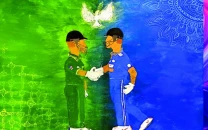New world, same violence: The questionable 'freedom' digital spaces enable for women
How the digital space replicates and helps reinforce patriarchal structures of control
1630996877-0/digital-freedom-(cropped)1630996877-0-640x480.webp)
In Pakistan, August is a month deeply intertwined with the concept of azadi, the Urdu word for freedom, and during an entire month of ‘bleeding green’ in celebration of a questionable liberation, it is easy to gloss over the spilling of all that red across the country. The word 'azad' holds a unique place in the Urdu lexicon, inspiring equal levels of reverence, pride, and in the context of women, utter hostility and revulsion. While an azad mulk, a free country, is cause for celebration and revelry, an azad aurat, or a free woman, is met with accusations of cultural degradation, an active threat to the nation at best, and a justification for barbaric violence against her at worst.
There is perhaps no better encapsulation of this than the recent assault of a singular woman at Greater Iqbal Park, Lahore last month by a hoard of over 400 men during Independence Day celebrations, all under the shadow of the Minar-e-Pakistan. Ayesha Akram, a TikToker, saw not only her physical person attacked but also found her character placed under exceedingly negative scrutiny. For many, Akram’s ‘digital freedoms’, her visibility on TikTok and thus her supposed questionable morality, validated the attack.
The digital world, at the surface level at least, seems to afford women greater freedom of opinion and expression. However, the violence enacted upon women, so often justified using their online presence, leads one to question the supposed ‘freedom’ the digital realm seeks to enable altogether. The glaring unevenness of the digital playing field seems now more obvious than ever, aiding the replication of pre-existing patriarchal power structures, ultimately creating a fresh space populated by age-old violence. With questions of morality and respectability so deeply intertwined with both online and offline personas of women, how does their supposed moral standing affect the violence enacted upon them, and can a tool so deeply entrenched in patriarchal structures promise any level of liberation?
The recent incident in Lahore is not the first time a woman’s online presence has been weaponized against her and used to justify acts of violence. Most famously, Qandeel Baloch, in many ways Pakistan’s first social media star, was murdered in 2016 by her brother for posting risque videos and jeopardizing the ‘honourability’ of her family. Her ‘freedom’ was unacceptable.
An entangled mess
Social media, especially in its current form, is a uniquely late-21st century phenomenon. Its apparent newness, and subsequent supposed unfamiliarity, breed both hope and fear. At its best, this digital space is deemed a force of liberation, and at its worst, a breeding ground for violence. The truth appears to lie somewhere in between, seemingly inching closer and closer towards the latter with each passing day.
With violence in the physical world being enacted upon women taking up space and exercising their apparent freedoms in the digital realm, the claim that the two cannot be considered mutually exclusive is not a contested one. However, the relationship between the physical and digital worlds defies easy categorization. It is a relationship constantly in flux, with each of the two being informed by the other. The online space, however, is often championed for enabling freedom of expression to a far greater extent than the physical.
Shmyla, an activist dealing with issues of gender and online spaces, was quick to debunk the myth of a democratic digital world. “It’s not as democratic as people make it out to be. The main issue with these platforms is that they end up replicating the same power structures that exist in the offline world. There is an illusion that people can say anything they want, and while sometimes certain things do get past the barrier and go viral, it’s not as democratic. Populist opinions hold a lot of sway in these spaces,” she explained.
While the power of digital community building shines through as a saving grace, the activist asserts that there is still much to be done until the digital space can truly be used as a tool for any kind of liberation. “Women are able to access different frames of thought and communities that would otherwise be difficult in the offline world. Apart from this, I don’t believe it really helps ‘empower’ women. It’s more about making connections. There’s a lot more that needs to be done.”
The novelty of the digital space often leads to it being equated with progress, and ultimately the bettering of societies. However, for Dr Muhammad Moiz, a global policy practitioner with a strong interest in urbanism, governance reform in post-colonial states, and issues of gender and sexuality, the novel digital space brings with it novel problems through its interaction with preexisting power structures. For them, social media, and the subsequent visibility that it at times forces upon individuals, is an extra tool through which misogyny can be exercised. “Visibility begets violence,” they start, citing queer theory. “Technology is an entrant in a preexisting system, and it has its side effects. That’s what we’re seeing here. There are more tools to commit violence with. Visibility of violence seems to have increased because now you have a higher number of visible bodies to commit violence upon,” they added.
While Tik Tok and Instagram, as well as the increased visibility they offer, may be new, women, as well as those who chastise them for engaging in acts of self-expression and pleasure, predate social media. According to Dr Moiz, “We don’t normally get to see women dancing or doing their makeup on the streets. It feels novel somehow, but I would argue that women have existed who have been engaging in these acts well before TikTok.”
Elaborating on their point further, they explain that violence against these women has also always existed. They continued, after citing the example of a blogger by the name of Nosheen Islam who attempted to justify the attack on Ayesha Akram by claiming she was a trans woman, “If women who engage in such acts are killed after being labelled ‘gashti’, ‘randi’ or ‘khusra’, then we need to understand that these words predate social media. They’ve existed from before. And these women were being killed using these words before social media as well, with the violence being actively justified by the perpetrators.”
Blurring of social boundaries
Social media has led to a deterioration of the boundary between public and private. While attempts are made to share certain information with a certain audience, the ease of accessing information and the wildfire-like nature of it make gatekeeping difficult, especially when information is actively sought out. The weaponization of private information is a regular occurrence when it comes to enabling and justifying acts of violence, specifically against women.
“The presence of personal information online which can then be used against individuals makes the online space rather unsafe, for women in particular,” explains Shmyla. “You see this a lot with journalists, where people will use their private pictures to defame them and raise issues on their character even though that has nothing to do with the work they do,” the activist added.
With TikTok so often placed at the heart of this cultural war against moral degradation, Shmyla explains that much of the attention the app receives when it comes to questions of immorality may have to do with the visual nature of the platform, especially its emphasis on physical visibility. “People who create content on Tik Tok are forced to be more visible, as compared to other platforms such as Twitter,” she shared.
For Dr Moiz, this visibility comes at a cost. “We are used to hearing things like visibility is powerful, but indigenous queer people argue that invisibility is power. That you remain invisible and you choose visibility on your terms.”
To be visible means to put information about yourself out into the digital space, and according to Dr Moiz, access to information is where true power lies in our technocratic societies. They start off by explaining how attempts are often made to filter out and control what information reaches who. “People now may have access to information about you that you did not intend for them to have. Social media tried to circumvent this at first by introducing Facebook groups, Google Plus had circles and Instagram has close friends, but these are all technological tools that have been there from the get-go because people realized even then that information is capital.”
Elaborating further, Dr Moiz explains that the level of control someone has over these boundaries between varying narratives determines the level of power they command in society. “Our public and private information disposition are different with different people because we wish to create a certain kind of image and narrative for ourselves in front of them. How powerful you are depends on how much agency you have over maintaining these boundaries, and how well you can make all these varying narratives come back to suit you.”
Sharing an example of a woman who understood the power of a narrative and appropriated it accordingly, Zaimal Azad, a gender equality campaigner with experience working in the women’s sector in both the UK and Pakistan, cites the case of the undaunted social media star Qandeel Baloch.
Baloch took control of a narrative, one that was actively used against her. “What she was doing was exactly what men and society do to women, but she clocked onto that and said that if someone’s going to use my body it might as well be me,” explained Azad. Her unabashed and radical acceptance of the labels of immorality imposed upon her for her own gain gave the social media sensation power, which was ultimately a threat to a patriarchal system that benefits off of women’s submission in the face of the terror of being labelled as an ‘immoral’ outcast.
A crisis of honour and morality
Morality makes up the first line of defence for women who are the victims of violence, as well as the first line of attack of those who wish to justify the violence enacted upon them. This then begs the question, what is a moral woman? The impossibility of finding an objective answer to this question makes the ‘moral’ woman seem like an almost mythological figure, with no woman ever being able to fit the bill. Despite the elusiveness, women are forced to idealize an impossibility.
Bee Gul, a screenwriter popular for her well-rounded, realist female characters, after mulling over the question of women’s morality, reflected, “Although there is a very clear divide between a good woman and a bad woman, I always wonder what the definitions of the ‘good’ and ‘bad’ woman are. We never look at her as a whole, seeing her as either black or white.”
She added, “This ‘good woman syndrome’ is ingrained in the mind of a girl as soon as she is born. That’s what she carries forward, so the issue of morality becomes very deep-rooted.”
Echoing the previously stated sentiments on the label of ‘azad aurat’, the screenwriter explained, “A bad woman is an azad aurat. But, to me, an azad aurat is one who questions oppression and violence openly. All the victims of abuse who stand up for themselves suddenly become azad.”
Despite ‘immoral’ behaviour being deemed as the chief motivator behind violence against women, Azad asserts that whether a woman is considered morally upright or degenerate has no bearing on whether she is protected from patriarchal violence. She shared, “I was listing down the recent instances of rape in the news, and the variation in the kind of women against whom the violence was being enacted really stood out. There were cis women, trans women, women from different class backgrounds, TikTokers, a 50-60-year-old woman who was raped. Our response to it is different depending on who we think is deserving of our sympathy.”
If the victim is deemed a ‘good’ woman, complete with an almost childlike innocence and the helplessness of a lamb, she is assaulted for her lack of worldliness. If the victim is labelled as immoral, she is assaulted as a means to a badge of honour for ‘correcting’ her deviant behaviour. The hypermasculine underpinnings of power and control remain consistent.
The ‘honourability’ in question may not always be a woman’s own either. Azad cites the case of Mukhtar Mai, who was gang-raped in 2002 as retribution for her younger brother’s alleged illicit affair with a woman from a rival tribe. While Mukhtara Mai was subsequently labelled as immoral for speaking out, joining the ranks of the azad aurtein considered cultural and national threats, the original violence involved her acting merely as a vessel for the honour of another. She explains, “If you think about honour-based violence against someone like Mukhtara Mai, she herself wasn’t perceived as immoral, but it was because of what someone else had done. It doesn’t matter if she’s honourable or not. She becomes a mechanism to punish somebody else.”
The impossibility of safeguarding oneself from violence stemming out of assumed moral degradation can perhaps be dealt with best by discarding these ideas of morality altogether. Through the example of trans women, who have faced a perpetually rising tide of barbaric violence and gang assault, Dr Moiz stresses the importance of rejecting patriarchal labels altogether. “Trans women are open to playing the good woman and the bad woman because why choose? Use these patriarchal concepts for your own gain. Our entire narrative is based on women trying very hard to rid themselves of labels,” they explain.
Elaborating on how seeking out validation from the patriarchal system at play works only to perpetuate this violent system of control, they add, “‘Not all female TikTokers have bad characters’, through this painting of the modern woman as the ‘good woman’ we are also simultaneously legitimizing violence against anyone who doesn’t fit that image. Who is the bad woman? Depends on who you ask. No matter what you do, you will be considered a dishonourable woman by someone.”
Radical shift
The digital space has the potential to become a tool for liberation, but the road to freedom is paved with radical, and at times uncomfortable, change. Dr Moiz, while discussing the disconnected nature of Pakistan’s feminist movement, asserts the importance of shifting away from the trap of single narratives that the movement seems to be playing into at the moment. They share, “Even the feminist struggle for liberation is consumed by what information this fight for liberation wants to be portrayed of itself, while being unable to control the narrative.”
Elaborating further on how any attempt at freedom and liberation must be born out of a rejection of divides between class and the questions of respectability they entail, Dr Moiz adds, “I would say that the digital space hasn’t liberated women, it has confined women even more because it has introduced new ideas of feminine propriety. It has introduced new moral questions about what it is to be a woman in 2021 on social media. Contemporary feminism is losing the battle because it’s trying to lean into a narrative not understanding that its battle is not for a narrative, it is for multiple narratives. It cannot solely appeal to middle-class, parha likha sensibilities.”
Liberation cannot be achieved, through digital means or otherwise, while simultaneously preserving patriarchal structures such as class, race and gender. “Kis se haqooq maang rahein hain? Who are you appealing to? The heteropatriarchal system?” they ask, concluding with a question at the heart of every struggle for true freedom, “Where is the rebellion?”



















COMMENTS
Comments are moderated and generally will be posted if they are on-topic and not abusive.
For more information, please see our Comments FAQ